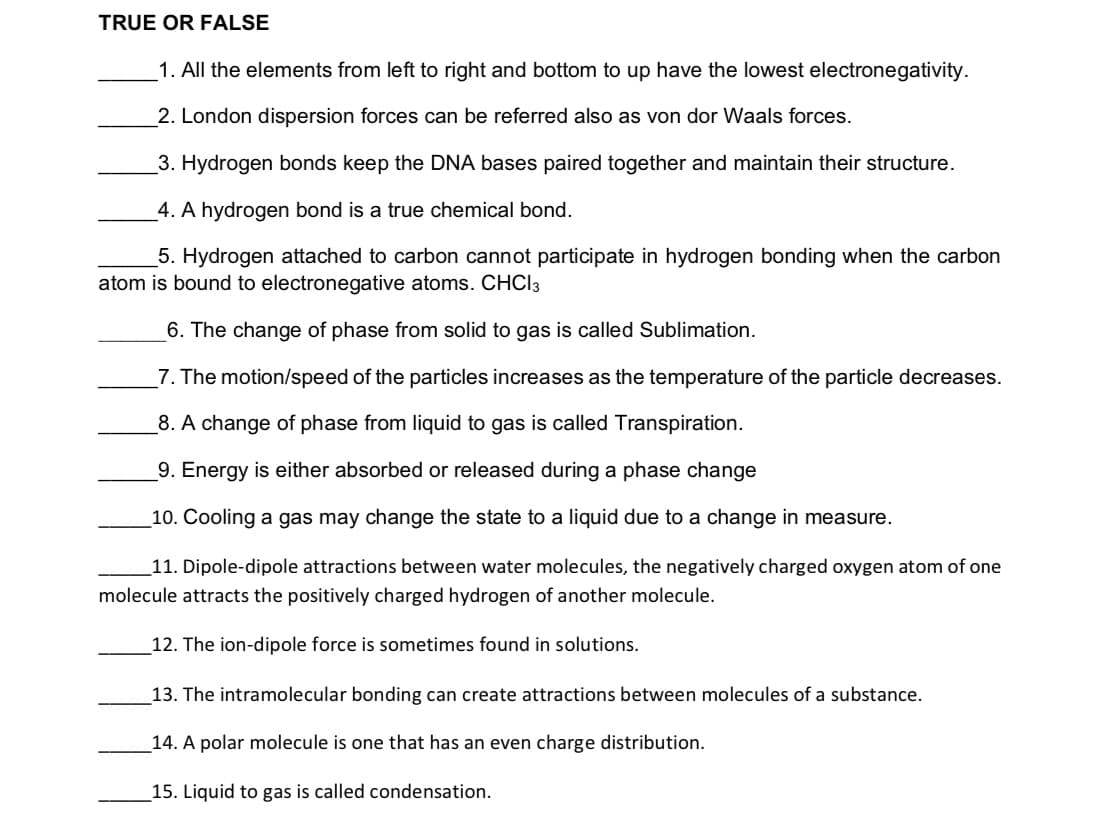TRUE OR FALSE 1. All the elements from left to right and bottom to up have the lowest electronegativity. 2. London dispersion forces can be referred also as von dor Waals forces. 3. Hydrogen bonds keep the DNA bases paired together and maintain their structure. 4. A hydrogen bond is a true chemical bond. 5. Hydrogen attached to carbon cannot participate in hydrogen bonding when the carbon atom is bound to electronegative atoms. CHCI3 6. The change of phase from solid to gas is called Sublimation. _7. The motion/speed of the particles increases as the temperature of the particle decreases. 8. A change of phase from liquid to gas is called Transpiration. 9. Energy is either absorbed or released during a phase change 10. Cooling a gas may change the state to a liquid due to a change in measure. 11. Dipole-dipole attractions between water molecules, the negatively charged oxygen atom of one molecule attracts the positively charged hydrogen of another molecule. 12. The ion-dipole force is sometimes found in solutions. 13. The intramolecular bonding can create attractions between molecules of a substance. 14. A polar molecule is one that has an even charge distribution. 15. Liquid to gas is called condensation.
Formal Charges
Formal charges have an important role in organic chemistry since this concept helps us to know whether an atom in a molecule is neutral/bears a positive or negative charge. Even if some molecules are neutral, the atoms within that molecule need not be neutral atoms.
Polarity Of Water
In simple chemical terms, polarity refers to the separation of charges in a chemical species leading into formation of two polar ends which are positively charged end and negatively charged end. Polarity in any molecule occurs due to the differences in the electronegativities of the bonded atoms. Water, as we all know has two hydrogen atoms bonded to an oxygen atom. As oxygen is more electronegative than hydrogen thus, there exists polarity in the bonds which is why water is known as a polar solvent.
Valence Bond Theory Vbt
Valence bond theory (VBT) in simple terms explains how individual atomic orbitals with an unpaired electron each, come close to each other and overlap to form a molecular orbital giving a covalent bond. It gives a quantum mechanical approach to the formation of covalent bonds with the help of wavefunctions using attractive and repulsive energies when two atoms are brought from infinity to their internuclear distance.


Trending now
This is a popular solution!
Step by step
Solved in 3 steps









